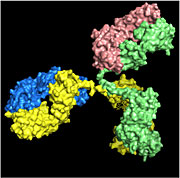- Number 350 |
- November 14, 2011
Antibody library project could unlock mysteries of human gene function

Structure of an antibody,
courtesy Los Alamos National
Laboratory.
A National Institutes of Health (NIH) grant to DOE's Los Alamos National Laboratory Bioscience Division could help unravel the gnarly secrets of how many human genes function.
Originally discovered in the Human Genome Project, the approximately 20,000 genes of the human body have been slow to reveal their exact roles. And one of the best tools for exposing a gene’s function is to take the protein it produces and generate specific antibodies, usually by vaccinating mice or rabbits. Antibodies are specialized proteins the immune system deploys to block the actions of potentially harmful bacteria and viruses.
By looking at antibodies, researchers can identify where, in a cell, genes are active and under what conditions they increase or decrease their expression. Antibodies are also one of the fastest growing classes of new therapeutics, with sales of about $40 billion in 2010.
With the new NIH Common Fund grant of more than $4 million, researchers led by Andrew Bradbury aim to develop an automated pipeline to generate antibodies against human gene products, without using animals.
Instead Dr. Bradbury’s team will use "antibody libraries" expressed in bacteria and bakers yeast. These libraries are enormous, comprising billions of different antibodies, and the ultimate goal is to identify antibodies in the libraries that recognize each human protein. The broad availability of antibodies against all human proteins will facilitate the understanding of human disease and provide likely targets for therapeutic intervention, with the antibodies themselves potentially becoming therapeutic leads.
This project will leverage much of the technology that has been developed over the years at LANL, including flow cytometry, antibody libraries and fluorescent protein technology, and has the potential to create a set of tools applicable to many different problems of interest to sponsors beyond NIH, including the U.S. Department of Energy and Department of Defense.Submitted by DOE’s Los Alamos National Laboratory
